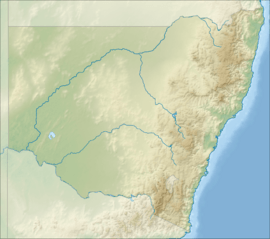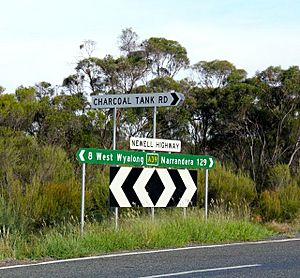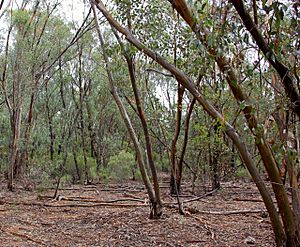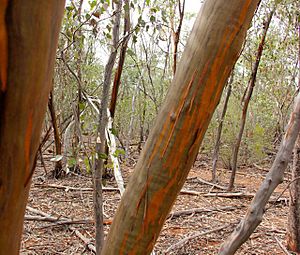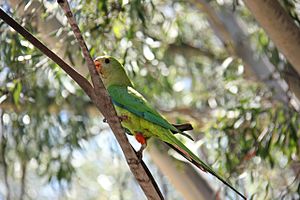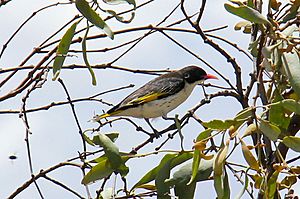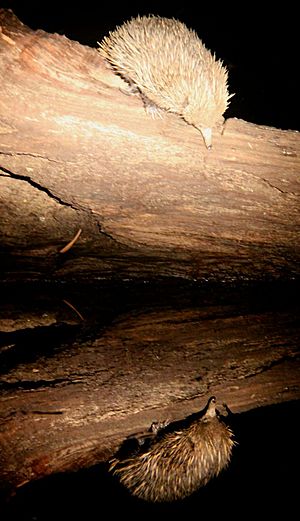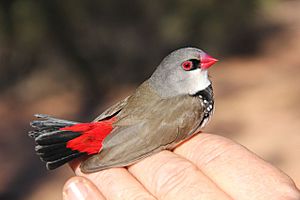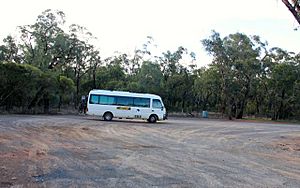Charcoal Tank Nature Reserve facts for kids
Quick facts for kids The Charcoal Tank Nature ReserveNew South Wales |
|
|---|---|
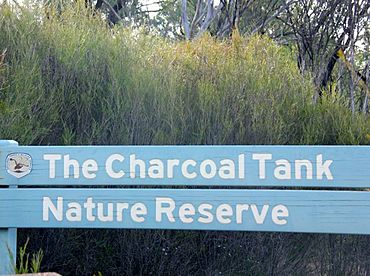
The Charcoal Tank Nature Reserve
|
|
| Nearest town or city | West Wyalong |
| Established | May 1966 |
| Area | 0.86 km2 (0.3 sq mi) |
| Managing authorities | NSW National Parks and Wildlife Service |
| Website | The Charcoal Tank Nature Reserve |
The Charcoal Tank Nature Reserve is a special protected area in New South Wales, Australia. It's like a safe home for native plants and animals. This reserve is about 86 hectares (that's like 120 football fields!) and is located 10 kilometers south of West Wyalong. You can get there from the Newell Highway.
This reserve is super important because most of the land around it has been cleared. It's one of the few places left with its original plants and wildlife.
Contents
What is The Charcoal Tank Nature Reserve?
The land around the reserve has been changed a lot for farms and roads. So, The Charcoal Tank Nature Reserve is like a small island of nature. It has rare plants called mallee and mallee–broombush. These plant types are critically endangered. In fact, only three protected areas in New South Wales have them!
The reserve is mostly flat. It has dry, red, clay soil. There are three man-made dams that collect water. These dams are along a natural water path.
The traditional owners of this land are the Wiradjuri people. They lived here for over 40,000 years. We don't know much about how they used the reserve. But it was probably a place to gather food. Later, it was used by people moving livestock. It also had a public watering hole. In 1966, it officially became The Charcoal Tank Nature Reserve.
Weather in the Reserve
The weather here is quite dry. Summers are hot, and winters are cold. The reserve is about 257 meters above sea level. The average lowest temperature is 3.0°C. The average highest temperature is 34.1°C.
It can be quite humid in winter (up to 90%). In summer, it's less humid (around 48%). Wind speeds are usually between 10.8 and 20.4 kilometers per hour. The amount of rain changes a lot each year. The area has also had some very dry periods.
Animals and Plants
Even though the reserve is small, it has many different kinds of plants and animals. It's a vital spot for many species. This includes birds that travel long distances. Because it's small and alone, it can't support huge numbers of animals.
Fires haven't happened here since 1966. This means the plants have been growing for a long time without being burned.
Plants of the Reserve
The reserve has three main types of plant groups.
- The most common group is mallee-broombush. This includes plants like Melaleuca uncinata (broombush), Eucalyptus polybractea (blue mallee), Eucalyptus viridis (green mallee), and Eucalyptus behriana (bull mallee). Two other special shrubs here are Kunzea parvifolia (purple kunzea) and Acacia rhigiophylla (dagger-leaved wattle).
- The second largest group is a mix of eucalyptus and callitris trees. These include Eucalyptus microcarpa (inland grey box), Eucalyptus sideroxylon, and Callitris endlicheri (black cypress pine). This area also has native shrubs like Cassinia laevis (cough bush), Santalum acuminatum (quandong), and Acacia hakeoides (hakea wattle).
- The smallest group has Callitris endlicheri (black cypress pine), Eucalyptus Dwyeri (Dwyer's red-gum), and Acacia doratoxylon (currawang).
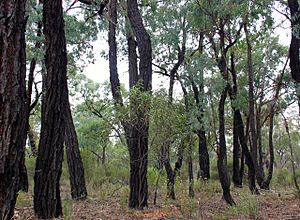
The mallee and broombush plants are critically endangered. This means they are at high risk of disappearing forever. People have cut down many of these plants since Europeans arrived.
Animals of the Reserve
Birds are the most common animals here. Over 165 different bird species have been seen! Scientists have even banded 96 species to study them. Some birds that live here, like the brown treecreeper and varied sittella, are listed as vulnerable. This means their numbers are decreasing.
Other birds that visit the reserve are also vulnerable. These include the painted honeyeater, superb parrot, regent honeyeater, and the swift parrot. The regent honeyeater and swift parrot are even listed as endangered in Australia.
Sadly, some birds have disappeared from the reserve in the last 30 years. These include the malleefowl and crested shrike-tit. The malleefowl has disappeared because of predators like red foxes and cats. Also, their homes have been destroyed or broken up. Other animals like European rabbits and goats also cause problems.
Recently, scientists have seen fewer of some common birds. These include the grey-crowned babbler, shy heath wren, diamond firetail, and eastern yellow robin.
Other animals in the reserve include:
- Mammals: eastern grey kangaroo, swamp wallaby, short-beaked echidna, and sugar glider.
- Amphibians: Five different kinds of frogs and toads.
- Reptiles: Nine different kinds, like the lace monitor and eastern brown snake.
- Invertebrates: common freshwater yabby and at least nine types of butterflies. This includes the spotted Jezebel and Australian painted lady. A rare butterfly, the western dusky-blue, also depends on the mallee plants here.
Some pest animals are sometimes found in the reserve. These include cats, red foxes, common starlings, European rabbits, European brown hares, house mice, and pigs.
Dangers to the Reserve
Because the reserve is small and surrounded by cleared land, it faces many dangers. These include:
- Climate change: Changes in weather patterns can cause more droughts, fires, and storms. This makes other problems worse.
- Edge effects: The edges of the reserve are next to farms and roads. This means it's more open to strong weather, erosion, and pollution from nearby farms. Also, pest plants and animals can easily enter.
- Pest species: Animals like foxes and rabbits can harm native wildlife and plants.
- Pollution: Rubbish from the nearby rest stop can attract pests and cause problems.
- Fires: High-intensity fires can destroy slow-growing plants like the black cypress pine.
- Fragmentation: The reserve is cut off from other natural areas. This makes it hard for animals to move around. If a species disappears from the reserve, it's very hard for it to come back. Animals trying to cross cleared land are also in danger from cars.
The rest stop next to the Newell Highway makes it easy for people to access the reserve. Unfortunately, this area often has rubbish and can be used as a toilet. This can attract pest animals and increase the risk of fires.
Climate change is a big threat. Warmer temperatures and less rain can make it harder for animals to find food. This can affect their survival. For example, a study showed that white-plumed honeyeaters in the reserve have grown larger as temperatures increased and rainfall decreased. This means smaller birds might not survive as well.
If wildfires happen more often, slow-growing plants like the black cypress pine could be lost. These trees rely on seeds to grow back after a fire. Faster-growing eucalyptus trees might take over instead.
How the Reserve is Managed
The Charcoal Tank Nature Reserve is looked after by the New South Wales Parks and Wildlife Service (NSW NPWS). Since 1966, they have protected the mallee and broombush plants from being cut down. They also stop the problems that used to happen when the area was a camp for traveling animals, like too much grazing and erosion.
The NSW NPWS has a plan to manage the reserve. This plan helps them protect its special plants and animals. Some immediate tasks include:
- Keeping the fences in good repair to stop farm animals from entering.
- Controlling erosion from runoff.
- Reducing pollution from the rest stop.
They also work to protect roadside plants and private land. This helps connect The Charcoal Tank Nature Reserve to bigger reserves like Buddigower Nature Reserve.
Scientists have been studying birds in the reserve since 1986. They visit often to band birds. This helps them understand how the birds are doing. This information is very important for managing the reserve.
The NSW NPWS works with the local community, including the West Wyalong Aboriginal Land Council and local fire brigades. They have a fire management plan. This plan says that any fires in the reserve must be put out quickly. Controlled burns are only allowed after careful study, because of the critically endangered mallee-broombush plants.
Managing the reserve is a challenge because different animals and plants need different conditions. For example, some birds like areas that haven't burned for a long time. Others prefer areas with plants of different ages after a fire.


